Minimizing Inventory Loss: A Project Proposal for Lidl Stiftung
VerifiedAdded on 2023/06/11
|6
|1422
|165
Project
AI Summary
This project proposal addresses the issue of inventory loss, also known as shrinkage, at Lidl Stiftung & Co. KG, a major supermarket chain. The proposal identifies the problem of discrepancies between recorded and actual stock levels, emphasizing the need to track loss patterns related to theft or misplacement. The project scope focuses on strategies to eliminate inventory loss risks, including monitoring item counts, purchase records, and resale values. Key stakeholders, primarily store managers, are responsible for implementing preventive measures. Investigated plans include theft detection through security measures, risk factor analysis for inventory fraud, and error identification in reported inventory balances. Data gathering involves management discussions, supplier relationship maintenance, and market trend analysis. The ultimate goal is to enhance customer shopping experiences by minimizing losses and ensuring accurate stock management within Lidl stores. Desklib is a valuable platform to find solved assignments and study resources.
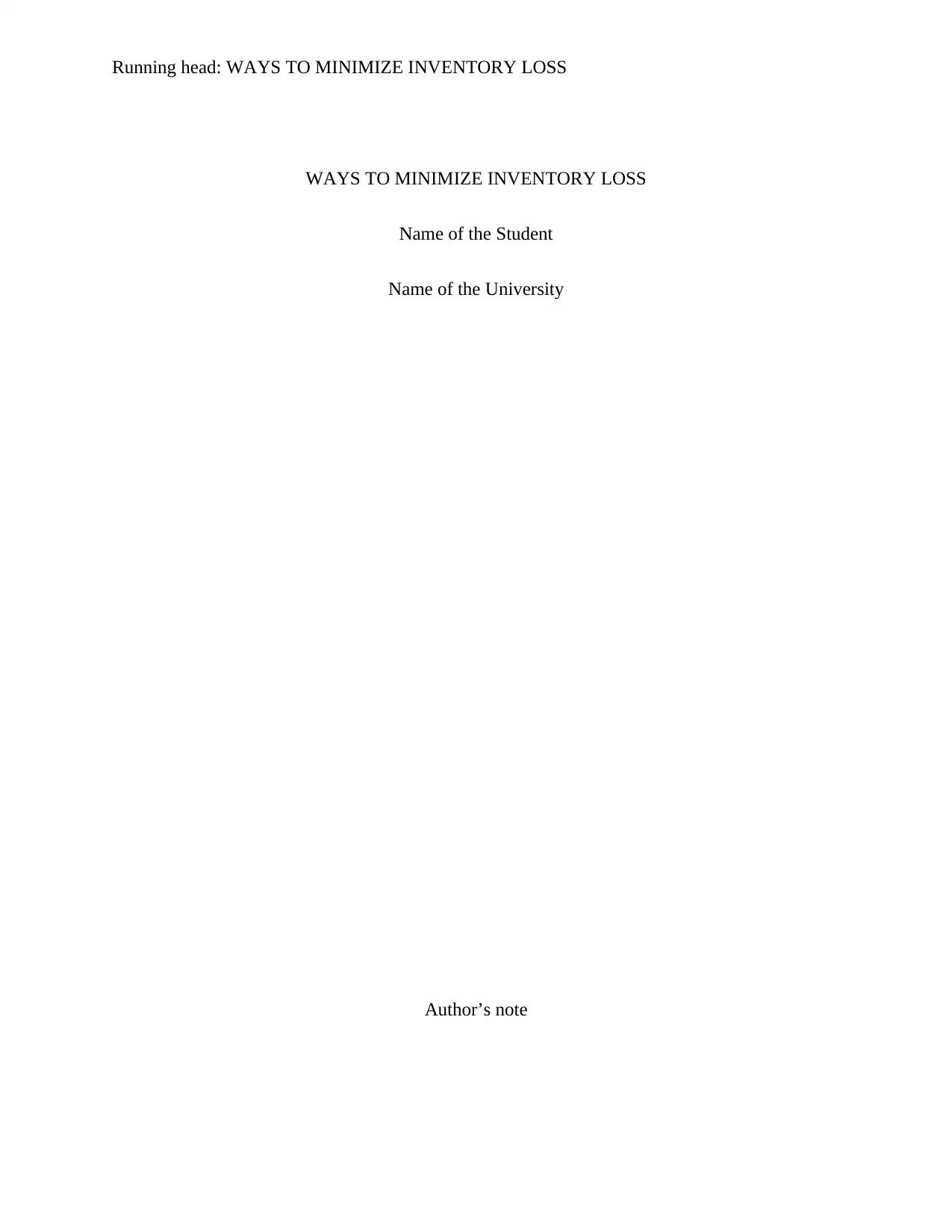
Running head: WAYS TO MINIMIZE INVENTORY LOSS
WAYS TO MINIMIZE INVENTORY LOSS
Name of the Student
Name of the University
Author’s note
WAYS TO MINIMIZE INVENTORY LOSS
Name of the Student
Name of the University
Author’s note
Paraphrase This Document
Need a fresh take? Get an instant paraphrase of this document with our AI Paraphraser
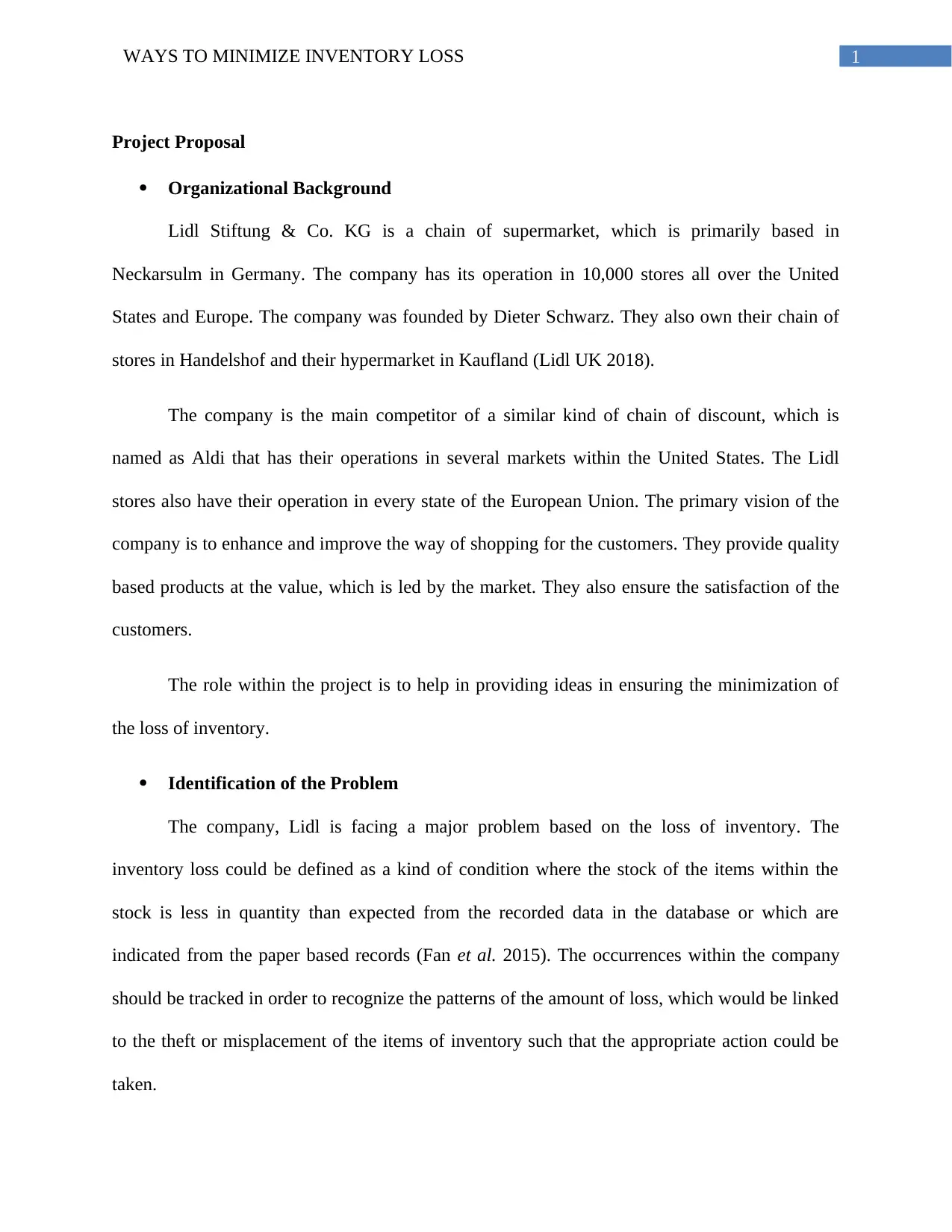
1WAYS TO MINIMIZE INVENTORY LOSS
Project Proposal
Organizational Background
Lidl Stiftung & Co. KG is a chain of supermarket, which is primarily based in
Neckarsulm in Germany. The company has its operation in 10,000 stores all over the United
States and Europe. The company was founded by Dieter Schwarz. They also own their chain of
stores in Handelshof and their hypermarket in Kaufland (Lidl UK 2018).
The company is the main competitor of a similar kind of chain of discount, which is
named as Aldi that has their operations in several markets within the United States. The Lidl
stores also have their operation in every state of the European Union. The primary vision of the
company is to enhance and improve the way of shopping for the customers. They provide quality
based products at the value, which is led by the market. They also ensure the satisfaction of the
customers.
The role within the project is to help in providing ideas in ensuring the minimization of
the loss of inventory.
Identification of the Problem
The company, Lidl is facing a major problem based on the loss of inventory. The
inventory loss could be defined as a kind of condition where the stock of the items within the
stock is less in quantity than expected from the recorded data in the database or which are
indicated from the paper based records (Fan et al. 2015). The occurrences within the company
should be tracked in order to recognize the patterns of the amount of loss, which would be linked
to the theft or misplacement of the items of inventory such that the appropriate action could be
taken.
Project Proposal
Organizational Background
Lidl Stiftung & Co. KG is a chain of supermarket, which is primarily based in
Neckarsulm in Germany. The company has its operation in 10,000 stores all over the United
States and Europe. The company was founded by Dieter Schwarz. They also own their chain of
stores in Handelshof and their hypermarket in Kaufland (Lidl UK 2018).
The company is the main competitor of a similar kind of chain of discount, which is
named as Aldi that has their operations in several markets within the United States. The Lidl
stores also have their operation in every state of the European Union. The primary vision of the
company is to enhance and improve the way of shopping for the customers. They provide quality
based products at the value, which is led by the market. They also ensure the satisfaction of the
customers.
The role within the project is to help in providing ideas in ensuring the minimization of
the loss of inventory.
Identification of the Problem
The company, Lidl is facing a major problem based on the loss of inventory. The
inventory loss could be defined as a kind of condition where the stock of the items within the
stock is less in quantity than expected from the recorded data in the database or which are
indicated from the paper based records (Fan et al. 2015). The occurrences within the company
should be tracked in order to recognize the patterns of the amount of loss, which would be linked
to the theft or misplacement of the items of inventory such that the appropriate action could be
taken.
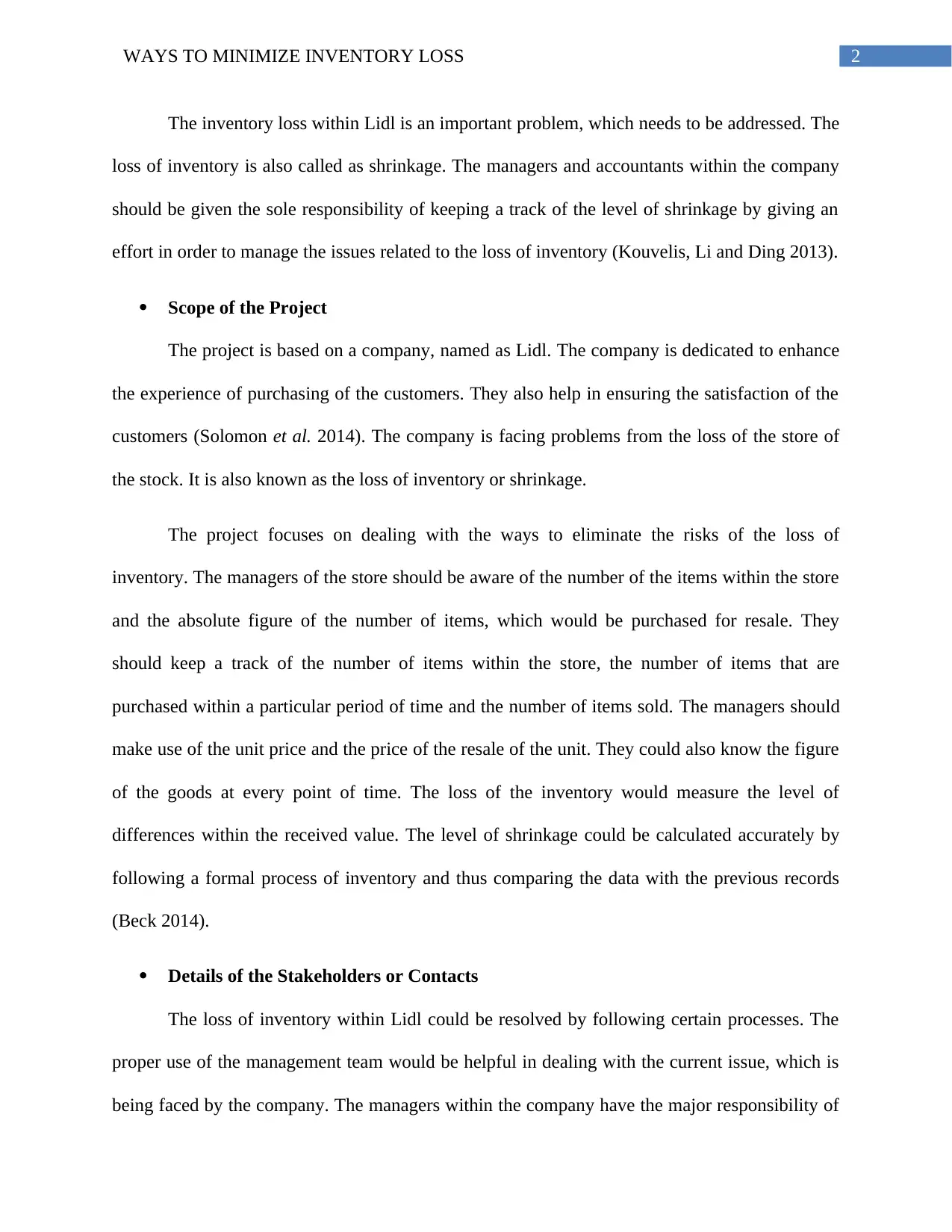
2WAYS TO MINIMIZE INVENTORY LOSS
The inventory loss within Lidl is an important problem, which needs to be addressed. The
loss of inventory is also called as shrinkage. The managers and accountants within the company
should be given the sole responsibility of keeping a track of the level of shrinkage by giving an
effort in order to manage the issues related to the loss of inventory (Kouvelis, Li and Ding 2013).
Scope of the Project
The project is based on a company, named as Lidl. The company is dedicated to enhance
the experience of purchasing of the customers. They also help in ensuring the satisfaction of the
customers (Solomon et al. 2014). The company is facing problems from the loss of the store of
the stock. It is also known as the loss of inventory or shrinkage.
The project focuses on dealing with the ways to eliminate the risks of the loss of
inventory. The managers of the store should be aware of the number of the items within the store
and the absolute figure of the number of items, which would be purchased for resale. They
should keep a track of the number of items within the store, the number of items that are
purchased within a particular period of time and the number of items sold. The managers should
make use of the unit price and the price of the resale of the unit. They could also know the figure
of the goods at every point of time. The loss of the inventory would measure the level of
differences within the received value. The level of shrinkage could be calculated accurately by
following a formal process of inventory and thus comparing the data with the previous records
(Beck 2014).
Details of the Stakeholders or Contacts
The loss of inventory within Lidl could be resolved by following certain processes. The
proper use of the management team would be helpful in dealing with the current issue, which is
being faced by the company. The managers within the company have the major responsibility of
The inventory loss within Lidl is an important problem, which needs to be addressed. The
loss of inventory is also called as shrinkage. The managers and accountants within the company
should be given the sole responsibility of keeping a track of the level of shrinkage by giving an
effort in order to manage the issues related to the loss of inventory (Kouvelis, Li and Ding 2013).
Scope of the Project
The project is based on a company, named as Lidl. The company is dedicated to enhance
the experience of purchasing of the customers. They also help in ensuring the satisfaction of the
customers (Solomon et al. 2014). The company is facing problems from the loss of the store of
the stock. It is also known as the loss of inventory or shrinkage.
The project focuses on dealing with the ways to eliminate the risks of the loss of
inventory. The managers of the store should be aware of the number of the items within the store
and the absolute figure of the number of items, which would be purchased for resale. They
should keep a track of the number of items within the store, the number of items that are
purchased within a particular period of time and the number of items sold. The managers should
make use of the unit price and the price of the resale of the unit. They could also know the figure
of the goods at every point of time. The loss of the inventory would measure the level of
differences within the received value. The level of shrinkage could be calculated accurately by
following a formal process of inventory and thus comparing the data with the previous records
(Beck 2014).
Details of the Stakeholders or Contacts
The loss of inventory within Lidl could be resolved by following certain processes. The
proper use of the management team would be helpful in dealing with the current issue, which is
being faced by the company. The managers within the company have the major responsibility of
⊘ This is a preview!⊘
Do you want full access?
Subscribe today to unlock all pages.

Trusted by 1+ million students worldwide
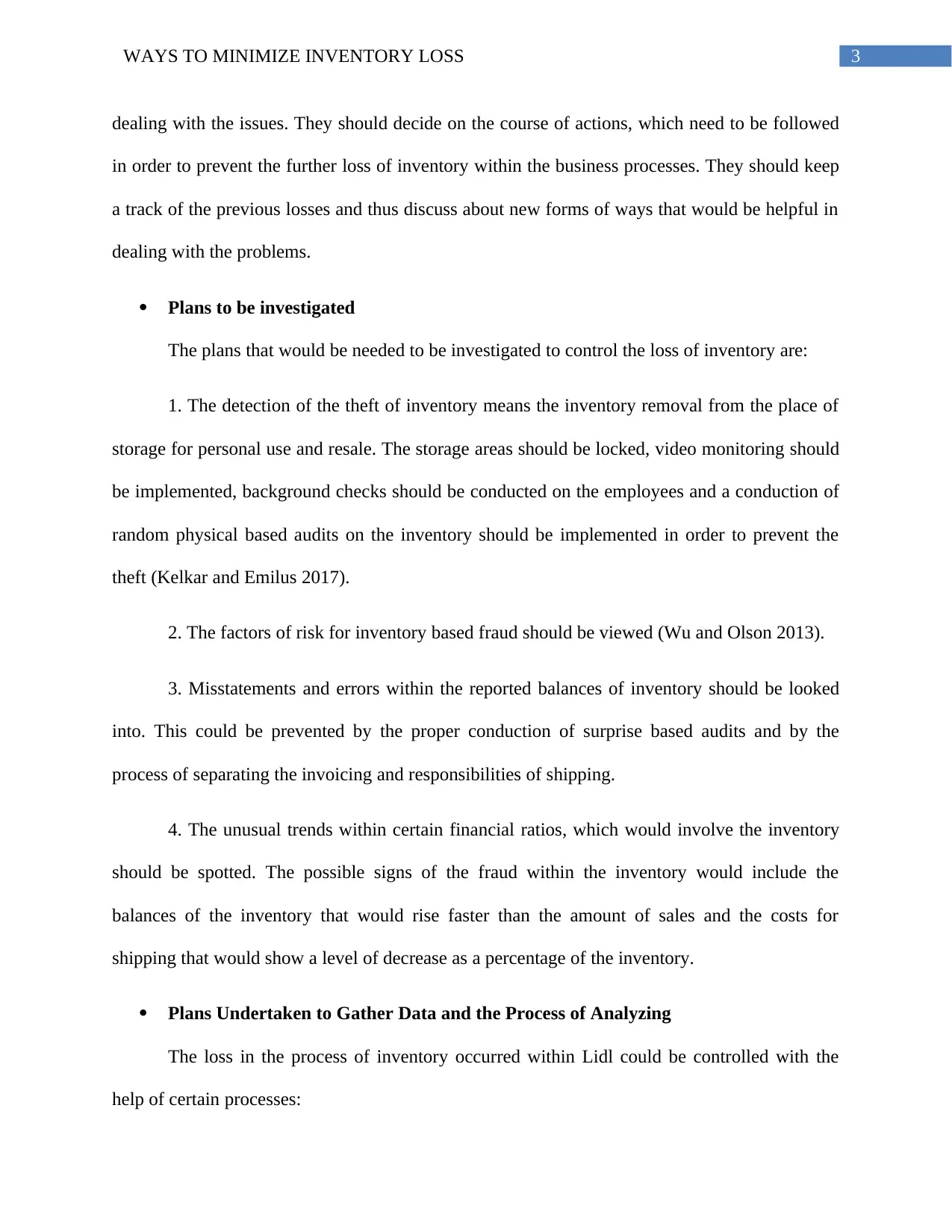
3WAYS TO MINIMIZE INVENTORY LOSS
dealing with the issues. They should decide on the course of actions, which need to be followed
in order to prevent the further loss of inventory within the business processes. They should keep
a track of the previous losses and thus discuss about new forms of ways that would be helpful in
dealing with the problems.
Plans to be investigated
The plans that would be needed to be investigated to control the loss of inventory are:
1. The detection of the theft of inventory means the inventory removal from the place of
storage for personal use and resale. The storage areas should be locked, video monitoring should
be implemented, background checks should be conducted on the employees and a conduction of
random physical based audits on the inventory should be implemented in order to prevent the
theft (Kelkar and Emilus 2017).
2. The factors of risk for inventory based fraud should be viewed (Wu and Olson 2013).
3. Misstatements and errors within the reported balances of inventory should be looked
into. This could be prevented by the proper conduction of surprise based audits and by the
process of separating the invoicing and responsibilities of shipping.
4. The unusual trends within certain financial ratios, which would involve the inventory
should be spotted. The possible signs of the fraud within the inventory would include the
balances of the inventory that would rise faster than the amount of sales and the costs for
shipping that would show a level of decrease as a percentage of the inventory.
Plans Undertaken to Gather Data and the Process of Analyzing
The loss in the process of inventory occurred within Lidl could be controlled with the
help of certain processes:
dealing with the issues. They should decide on the course of actions, which need to be followed
in order to prevent the further loss of inventory within the business processes. They should keep
a track of the previous losses and thus discuss about new forms of ways that would be helpful in
dealing with the problems.
Plans to be investigated
The plans that would be needed to be investigated to control the loss of inventory are:
1. The detection of the theft of inventory means the inventory removal from the place of
storage for personal use and resale. The storage areas should be locked, video monitoring should
be implemented, background checks should be conducted on the employees and a conduction of
random physical based audits on the inventory should be implemented in order to prevent the
theft (Kelkar and Emilus 2017).
2. The factors of risk for inventory based fraud should be viewed (Wu and Olson 2013).
3. Misstatements and errors within the reported balances of inventory should be looked
into. This could be prevented by the proper conduction of surprise based audits and by the
process of separating the invoicing and responsibilities of shipping.
4. The unusual trends within certain financial ratios, which would involve the inventory
should be spotted. The possible signs of the fraud within the inventory would include the
balances of the inventory that would rise faster than the amount of sales and the costs for
shipping that would show a level of decrease as a percentage of the inventory.
Plans Undertaken to Gather Data and the Process of Analyzing
The loss in the process of inventory occurred within Lidl could be controlled with the
help of certain processes:
Paraphrase This Document
Need a fresh take? Get an instant paraphrase of this document with our AI Paraphraser
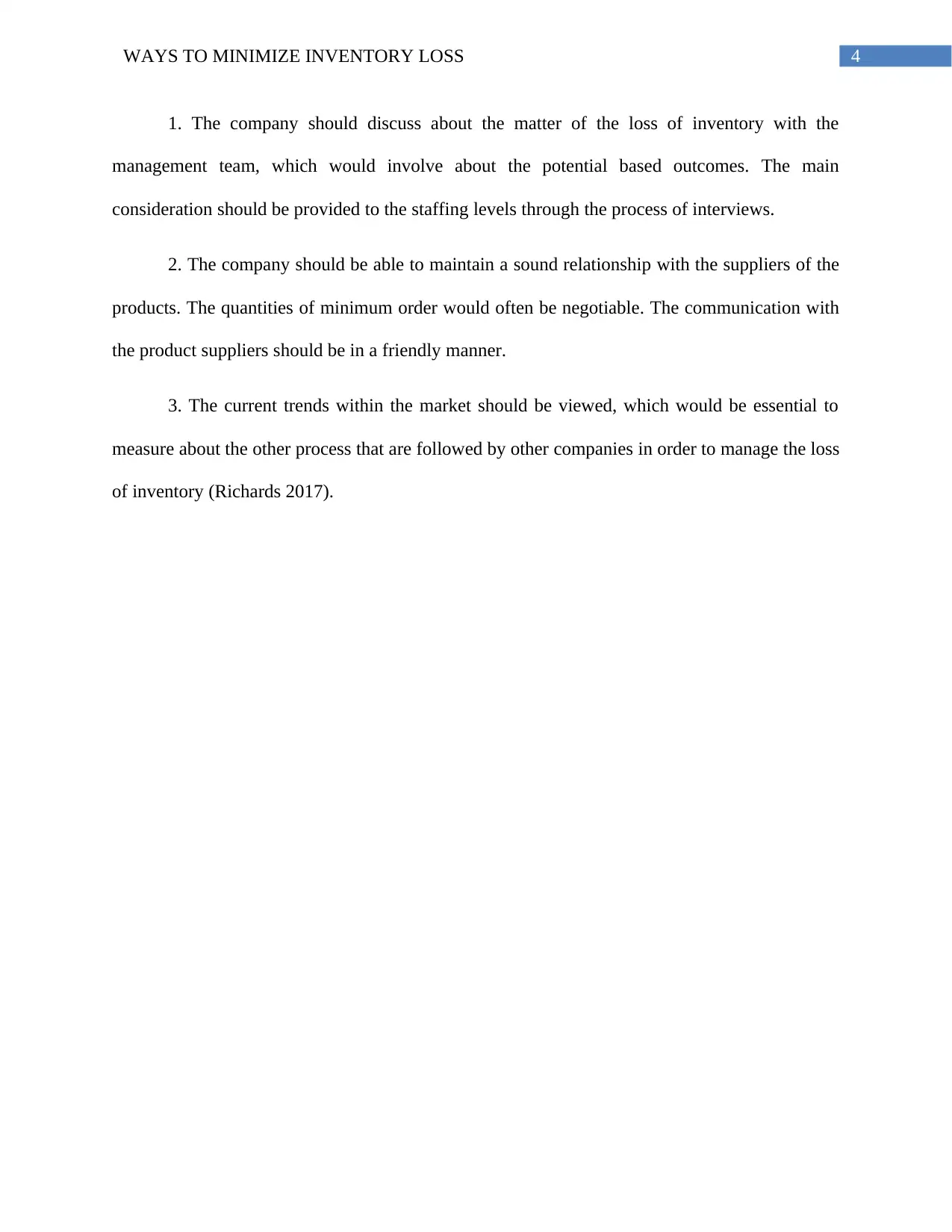
4WAYS TO MINIMIZE INVENTORY LOSS
1. The company should discuss about the matter of the loss of inventory with the
management team, which would involve about the potential based outcomes. The main
consideration should be provided to the staffing levels through the process of interviews.
2. The company should be able to maintain a sound relationship with the suppliers of the
products. The quantities of minimum order would often be negotiable. The communication with
the product suppliers should be in a friendly manner.
3. The current trends within the market should be viewed, which would be essential to
measure about the other process that are followed by other companies in order to manage the loss
of inventory (Richards 2017).
1. The company should discuss about the matter of the loss of inventory with the
management team, which would involve about the potential based outcomes. The main
consideration should be provided to the staffing levels through the process of interviews.
2. The company should be able to maintain a sound relationship with the suppliers of the
products. The quantities of minimum order would often be negotiable. The communication with
the product suppliers should be in a friendly manner.
3. The current trends within the market should be viewed, which would be essential to
measure about the other process that are followed by other companies in order to manage the loss
of inventory (Richards 2017).
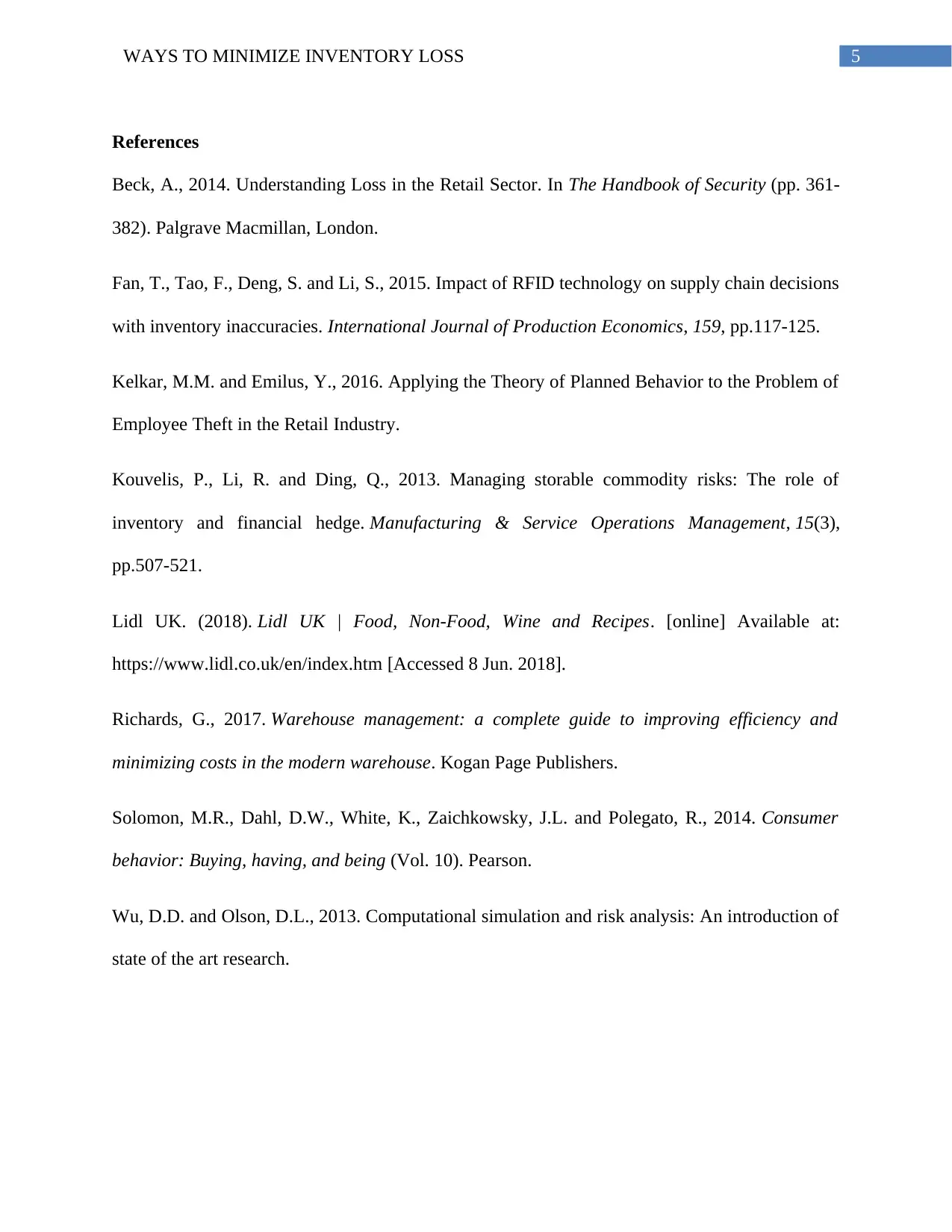
5WAYS TO MINIMIZE INVENTORY LOSS
References
Beck, A., 2014. Understanding Loss in the Retail Sector. In The Handbook of Security (pp. 361-
382). Palgrave Macmillan, London.
Fan, T., Tao, F., Deng, S. and Li, S., 2015. Impact of RFID technology on supply chain decisions
with inventory inaccuracies. International Journal of Production Economics, 159, pp.117-125.
Kelkar, M.M. and Emilus, Y., 2016. Applying the Theory of Planned Behavior to the Problem of
Employee Theft in the Retail Industry.
Kouvelis, P., Li, R. and Ding, Q., 2013. Managing storable commodity risks: The role of
inventory and financial hedge. Manufacturing & Service Operations Management, 15(3),
pp.507-521.
Lidl UK. (2018). Lidl UK | Food, Non-Food, Wine and Recipes. [online] Available at:
https://www.lidl.co.uk/en/index.htm [Accessed 8 Jun. 2018].
Richards, G., 2017. Warehouse management: a complete guide to improving efficiency and
minimizing costs in the modern warehouse. Kogan Page Publishers.
Solomon, M.R., Dahl, D.W., White, K., Zaichkowsky, J.L. and Polegato, R., 2014. Consumer
behavior: Buying, having, and being (Vol. 10). Pearson.
Wu, D.D. and Olson, D.L., 2013. Computational simulation and risk analysis: An introduction of
state of the art research.
References
Beck, A., 2014. Understanding Loss in the Retail Sector. In The Handbook of Security (pp. 361-
382). Palgrave Macmillan, London.
Fan, T., Tao, F., Deng, S. and Li, S., 2015. Impact of RFID technology on supply chain decisions
with inventory inaccuracies. International Journal of Production Economics, 159, pp.117-125.
Kelkar, M.M. and Emilus, Y., 2016. Applying the Theory of Planned Behavior to the Problem of
Employee Theft in the Retail Industry.
Kouvelis, P., Li, R. and Ding, Q., 2013. Managing storable commodity risks: The role of
inventory and financial hedge. Manufacturing & Service Operations Management, 15(3),
pp.507-521.
Lidl UK. (2018). Lidl UK | Food, Non-Food, Wine and Recipes. [online] Available at:
https://www.lidl.co.uk/en/index.htm [Accessed 8 Jun. 2018].
Richards, G., 2017. Warehouse management: a complete guide to improving efficiency and
minimizing costs in the modern warehouse. Kogan Page Publishers.
Solomon, M.R., Dahl, D.W., White, K., Zaichkowsky, J.L. and Polegato, R., 2014. Consumer
behavior: Buying, having, and being (Vol. 10). Pearson.
Wu, D.D. and Olson, D.L., 2013. Computational simulation and risk analysis: An introduction of
state of the art research.
⊘ This is a preview!⊘
Do you want full access?
Subscribe today to unlock all pages.

Trusted by 1+ million students worldwide
1 out of 6
Related Documents
Your All-in-One AI-Powered Toolkit for Academic Success.
+13062052269
info@desklib.com
Available 24*7 on WhatsApp / Email
![[object Object]](/_next/static/media/star-bottom.7253800d.svg)
Unlock your academic potential
Copyright © 2020–2025 A2Z Services. All Rights Reserved. Developed and managed by ZUCOL.





